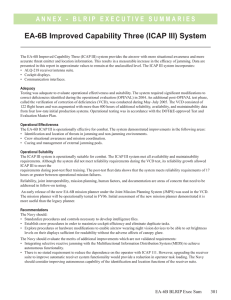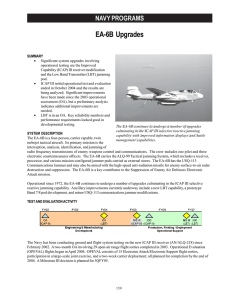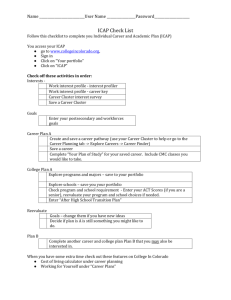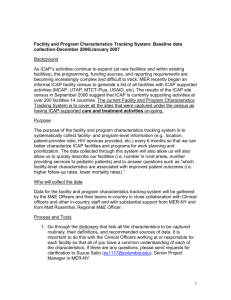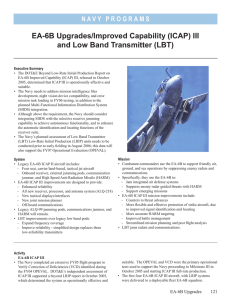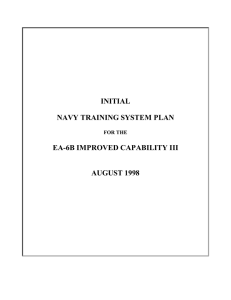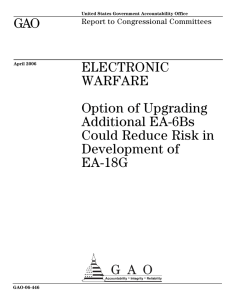EA-6B Upgrades / Improved Capability (ICAP) III
advertisement
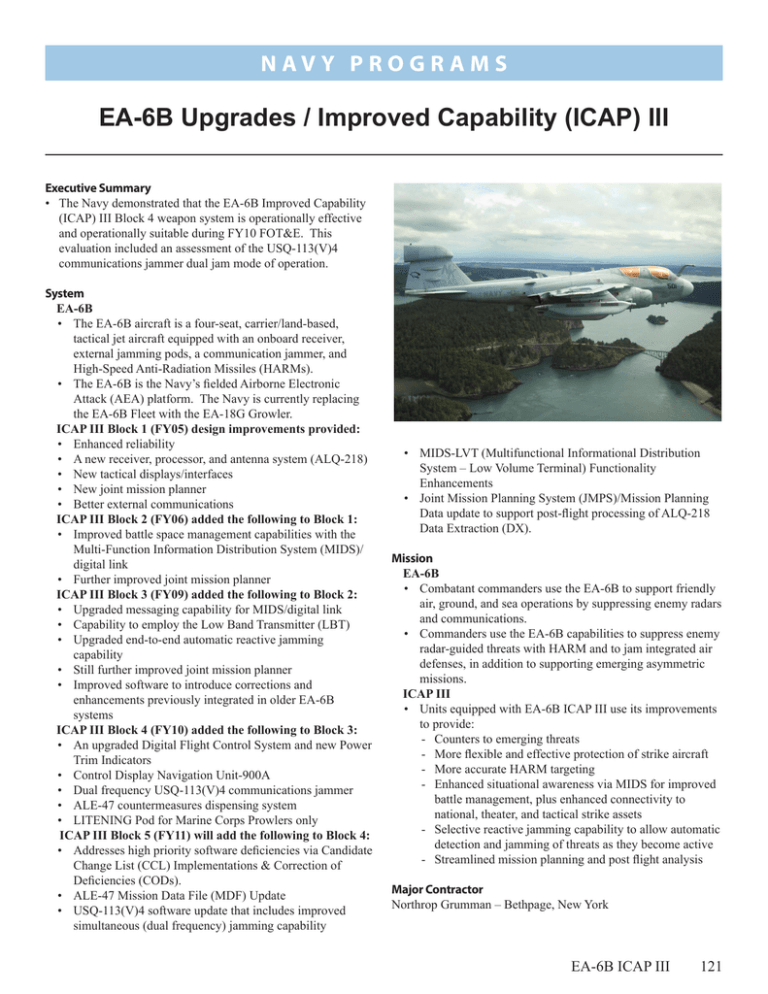
N a v y P ROGRAMS EA-6B Upgrades / Improved Capability (ICAP) III Executive Summary • The Navy demonstrated that the EA-6B Improved Capability (ICAP) III Block 4 weapon system is operationally effective and operationally suitable during FY10 FOT&E. This evaluation included an assessment of the USQ-113(V)4 communications jammer dual jam mode of operation. System EA-6B • The EA-6B aircraft is a four-seat, carrier/land-based, tactical jet aircraft equipped with an onboard receiver, external jamming pods, a communication jammer, and High-Speed Anti-Radiation Missiles (HARMs). • The EA-6B is the Navy’s fielded Airborne Electronic Attack (AEA) platform. The Navy is currently replacing the EA-6B Fleet with the EA-18G Growler. ICAP III Block 1 (FY05) design improvements provided: • Enhanced reliability • A new receiver, processor, and antenna system (ALQ-218) • New tactical displays/interfaces • New joint mission planner • Better external communications ICAP III Block 2 (FY06) added the following to Block 1: • Improved battle space management capabilities with the Multi-Function Information Distribution System (MIDS)/ digital link • Further improved joint mission planner ICAP III Block 3 (FY09) added the following to Block 2: • Upgraded messaging capability for MIDS/digital link • Capability to employ the Low Band Transmitter (LBT) • Upgraded end-to-end automatic reactive jamming capability • Still further improved joint mission planner • Improved software to introduce corrections and enhancements previously integrated in older EA-6B systems ICAP III Block 4 (FY10) added the following to Block 3: • An upgraded Digital Flight Control System and new Power Trim Indicators • Control Display Navigation Unit-900A • Dual frequency USQ-113(V)4 communications jammer • ALE-47 countermeasures dispensing system • LITENING Pod for Marine Corps Prowlers only ICAP III Block 5 (FY11) will add the following to Block 4: • Addresses high priority software deficiencies via Candidate Change List (CCL) Implementations & Correction of Deficiencies (CODs). • ALE-47 Mission Data File (MDF) Update • USQ-113(V)4 software update that includes improved simultaneous (dual frequency) jamming capability • MIDS-LVT (Multifunctional Informational Distribution System – Low Volume Terminal) Functionality Enhancements • Joint Mission Planning System (JMPS)/Mission Planning Data update to support post-flight processing of ALQ-218 Data Extraction (DX). Mission EA-6B • Combatant commanders use the EA-6B to support friendly air, ground, and sea operations by suppressing enemy radars and communications. • Commanders use the EA-6B capabilities to suppress enemy radar-guided threats with HARM and to jam integrated air defenses, in addition to supporting emerging asymmetric missions. ICAP III • Units equipped with EA-6B ICAP III use its improvements to provide: -- ­Counters to emerging threats -- ­More flexible and effective protection of strike aircraft -- ­More accurate HARM targeting -- ­Enhanced situational awareness via MIDS for improved battle management, plus enhanced connectivity to national, theater, and tactical strike assets -- ­Selective reactive jamming capability to allow automatic detection and jamming of threats as they become active -- ­Streamlined mission planning and post flight analysis Major Contractor Northrop Grumman – Bethpage, New York EA-6B ICAP III 121 N a v y P ROGRAMS Activity ICAP III Block 4 • The Commander, Operational Test and Evaluation Force (COTF) conducted operational test of the Block 4 configuration from January to April 2010. COTF released its test report in August 2010. • In order to arrive at a common fleet-wide configuration, the program office incorporated the software currently used in ICAP II aircraft into ICAP III Block 4 aircraft. Block 4 also incorporated the USQ-113(V)4 dual-frequency communication jammer, and provided further improved crew-vehicle interface performance. • COTF had previously tested Block 4 hardware upgrades in ICAP II developmental and operational testing. • The Navy conducted testing in accordance with the DOT&E-approved TEMP and test plan. ICAP III Block 5 • DOT&E approved a fifth revised TEMP (Revision E) in August 2010 that included additional detail of testing for the ICAP III Block 5 configuration. • Block 5 upgrades will continue to enhance crew vehicle interface performance through improving the overall Electronic Warfare Battle Management (EWBM) display and control in the cockpit. • In September 2010, DOT&E removed the EA-6B ICAP III from oversight. Assessment ICAP III Block 4 • The Navy demonstrated that the EA-6B Improved Capability (ICAP) III Block 4 weapon system is operationally effective and operationally suitable during FY10 FOT&E. This evaluation included an assessment of the USQ-113(V)4 communications jammer dual jam mode of operation. • The conduct of the Block 4 operational test was hampered by lack of test aircraft availability. Due to Fleet aircraft requirements, the Navy allocates only one test aircraft for the operational test squadron. The Navy operational test 122 EA-6B ICAP III squadron has been successful in garnering Fleet squadrons as “trusted agents” to assist with aircraft availability, but this process is unpredictable. The Navy acknowledges this limitation to test, which will remain a factor until the retirement of the EA-6B aircraft. • Block 4 continues to suffer from problems with the Joint Mission Planning System – Maritime (JMPS-M). Two of the three major deficiencies in JMPS-M reported in previous ICAP III testing remained unresolved. • Block 4 does not meet the threshold requirements in threat geolocation and built-in-test probability of correct detection, and suffered from deficiencies in the digital flight control system parts reliability and central display navigation unit display. The Navy program office is resolving these deficiencies. ICAP III Block 5 • The Block 5, an all-software configuration, should enhance the combat effectiveness of the ICAP III system and resolve Fleet-identified deficiencies in the aircraft software. • Test aircraft availability, as addressed above, will impact the test and development schedule of this configuration. Recommendations • Status of Previous Recommendations. There was no FY09 report for EA-6B Upgrades. The Navy satisfactorily addressed the two FY08 recommendations. • FY10 Recommendations. 1. The Navy should continue to plan, conduct, and analyze ICAP III testing as a total system evaluation in a mission environment. Deficiencies revealed during Block 4 testing need to be corrected under Block 5 and verified through testing. 2. The Navy should improve test aircraft and facility readiness to support timely execution of ongoing ICAP III developmental and operational testing.
